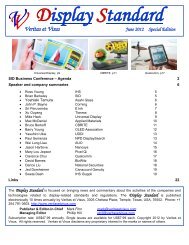You also want an ePaper? Increase the reach of your titles
YUMPU automatically turns print PDFs into web optimized ePapers that Google loves.
<strong>Veritas</strong> <strong>et</strong> <strong>Visus</strong> <strong>Display</strong> <strong>Standard</strong> February 2009<br />
<strong>Display</strong>Search reports half of mainstream panels will be green by 2011<br />
<strong>Display</strong>Search reports that in 2008, 20% of FPD shipments had green features, and this share is expected to soar to<br />
70% by 2012 and dominate the mark<strong>et</strong> by 2014. <strong>Display</strong>Search has created a new topical report dedicated to green<br />
FPDs: “Green Technology in Flat Panel <strong>Display</strong>s: Mark<strong>et</strong> Technology and Trends”. This new report examines<br />
environmental regulations, power-saving technologies, eco-friendly components, energy-saving manufacturing<br />
processes, and panel structure simplification efforts of the main three kinds of FPD: TFT LCD, OLED and plasma.<br />
<strong>Display</strong>Search defines green flat panel displays as those which me<strong>et</strong> one of the following conditions: using<br />
environmentally friendly components and materials; achieving lower power consumption by using new components<br />
or technologies; compliant with environmental regulations such as waste disposal; using production processes that<br />
reduce energy and materials consumed; compl<strong>et</strong>ely or partially recyclable after useful life; or use of green or ecofriendly<br />
concepts in product design, packaging m<strong>et</strong>hods or materials.<br />
As the figure shows, 2008 was the year of green FPD development, with green panels accounting for nearly 20% of<br />
the total $95.6 billion mark<strong>et</strong> for TFT LCD, OLED and plasma displays. <strong>Display</strong>Search defines 2009 as the year of<br />
green implementation, and panels and end products will be focusing on green promotion in 2010. Green FPD<br />
pen<strong>et</strong>ration will pass 50% in 2011<br />
and then achieve 100% in 2014.<br />
Regarding TFT LCD, there are<br />
currently four m<strong>et</strong>hods to<br />
implement green displays: new<br />
cell structures that increase panel<br />
transmittance or new technologies<br />
like PSA, COA, AMVA and<br />
SHA; energy-saving production<br />
processes, like photomask<br />
reduction, ink-j<strong>et</strong> printing of color<br />
filters, roll-to-roll production, and<br />
replacement of toxic gases in<br />
production; green components,<br />
such as glass, color filter, liquid crystal, optical films, driver ICs and LED backlights; and packaging, like spacesaving<br />
containers for b<strong>et</strong>ter transportation efficiency and recyclable packing materials. <strong>Display</strong>Search defines<br />
OLED as a naturally green technology, due to the simpler structure, reduced materials consumption, and lower<br />
power consumption. For plasma, there are three ways to implement green: high luminous efficiency, eco-friendly<br />
materials with lower EMI, and new manufacturing processes for materials reduction. The Green Technology in Flat<br />
Panel <strong>Display</strong>s Report also takes a close look at the green activities and technologies adopted by 12 major<br />
companies: Samsung, LG <strong>Display</strong>, AUO, CMO, CPT, Sharp, Sony, Lenovo, HP, Philips, Apple, Dell, Panasonic,<br />
and LG Electronics. http://www.displaysearch.com/<br />
Sharp launches nationwide TV and electronics recycling initiative<br />
Sharp Electronics Corporation has established a nationwide electronics program to provide consumers with no-cost,<br />
convenient recycling of Sharp televisions and other consumer audio and video products. Begun January 15, 2009<br />
Sharp will expand its current recycling program to 280 sites nationwide, including at least one location in all 50<br />
states, with hundreds more sites planned over the next three years. Sharp’s recycling program will utilize the<br />
infrastructure developed by the Electronics Manufacturers Recycling Management Company (MRM). A joint<br />
venture b<strong>et</strong>ween Panasonic, Sharp Electronics and Toshiba, MRM was established in September of 2007 to<br />
efficiently manage collection and recycling programs for electronics manufacturers in the United States. Consumers<br />
can drop off Sharp brand televisions and other Sharp consumer audio and video electronics products for free<br />
recycling. Panasonic and Toshiba products will also be accepted at these locations. A compl<strong>et</strong>e list of locations<br />
where Sharp products can be recycled is available on the MRM website. http://www.MRMrecycling.com<br />
84






